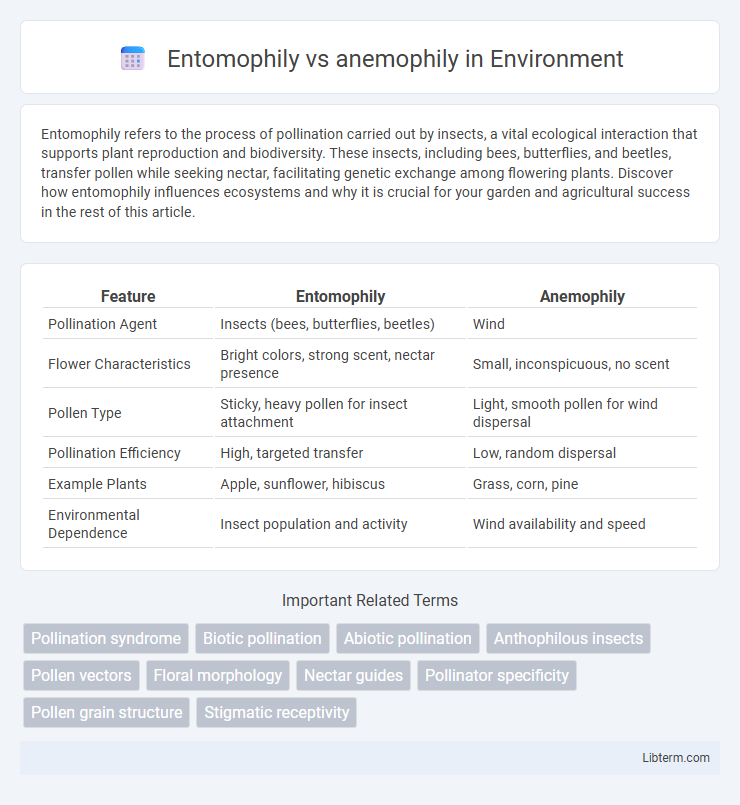Entomophily refers to the process of pollination carried out by insects, a vital ecological interaction that supports plant reproduction and biodiversity. These insects, including bees, butterflies, and beetles, transfer pollen while seeking nectar, facilitating genetic exchange among flowering plants. Discover how entomophily influences ecosystems and why it is crucial for your garden and agricultural success in the rest of this article.
Table of Comparison
| Feature | Entomophily | Anemophily |
|---|---|---|
| Pollination Agent | Insects (bees, butterflies, beetles) | Wind |
| Flower Characteristics | Bright colors, strong scent, nectar presence | Small, inconspicuous, no scent |
| Pollen Type | Sticky, heavy pollen for insect attachment | Light, smooth pollen for wind dispersal |
| Pollination Efficiency | High, targeted transfer | Low, random dispersal |
| Example Plants | Apple, sunflower, hibiscus | Grass, corn, pine |
| Environmental Dependence | Insect population and activity | Wind availability and speed |
Introduction to Plant Pollination Mechanisms
Entomophily refers to pollination facilitated by insects, where flowers produce nectar, scent, and bright colors to attract pollinators such as bees, butterflies, and beetles. Anemophily involves wind pollination, characterized by lightweight, abundant pollen grains and inconspicuous flowers that lack nectar and scent, optimizing pollen dispersal over large distances. These distinct mechanisms reflect adaptive strategies in angiosperms to maximize reproductive success via biotic or abiotic vectors.
Defining Entomophily: Insect-Mediated Pollination
Entomophily refers to the process of insect-mediated pollination, where insects like bees, butterflies, and beetles transfer pollen from one flower to another, facilitating fertilization. This type of pollination is crucial for the reproduction of many flowering plants and contributes significantly to biodiversity and ecosystem stability. Unlike anemophily, which relies on wind for pollen dispersal, entomophily involves active pollinator behavior, enhancing the precision and efficiency of pollen transfer.
Understanding Anemophily: Wind-Driven Pollination
Anemophily refers to wind-driven pollination where pollen grains are lightweight, smooth, and produced in large quantities to enhance dispersal by air currents. This pollination strategy is common in plants like grasses, conifers, and many trees, which have elongated stamens and feathery stigmas to efficiently capture airborne pollen. Understanding anemophily involves recognizing the adaptations that minimize dependence on animal pollinators, facilitating reproduction in open or wind-exposed habitats.
Key Differences Between Entomophily and Anemophily
Entomophily involves pollination primarily by insects such as bees, butterflies, and beetles, characterized by brightly colored flowers, strong fragrance, and nectar production to attract pollinators. Anemophily relies on wind for pollen transfer, with flowers typically small, inconspicuous, lack scent or nectar, and produce large quantities of lightweight pollen for effective dispersal. The key differences lie in pollination agents, flower morphology, pollen characteristics, and reproductive strategies adapted to either biotic or abiotic pollination mechanisms.
Morphological Adaptations in Entomophilous Plants
Entomophilous plants exhibit specialized morphological adaptations such as brightly colored petals, scented flowers, and nectar guides to attract insect pollinators. Their pollen grains tend to be larger and sticky, facilitating adherence to insects' bodies for effective transfer. The floral structure often includes landing platforms and tubular shapes to accommodate the feeding behavior of specific insects, enhancing pollination efficiency.
Structural Features of Anemophilous Plants
Anemophilous plants exhibit distinct structural features adapted for wind pollination, including small, inconspicuous flowers lacking bright petals or nectar, which reduces energy expenditure. These plants possess long, feathery stigmas and abundant, lightweight pollen grains designed to maximize capture and dispersal by wind. Typically, their stamens are prominently extended to release pollen efficiently, facilitating reproduction in open, breezy environments.
Ecological Significance of Entomophily
Entomophily, or insect pollination, plays a crucial ecological role by enhancing plant reproductive success and genetic diversity through targeted pollen transfer by specialized pollinators such as bees, butterflies, and beetles. This mutualistic relationship supports biodiversity by sustaining diverse plant communities and maintaining food webs, as many animal species depend on entomophilous plants for nutrition and habitat. In contrast to anemophily, which relies on wind for pollen dispersal and is less energy-efficient, entomophily fosters coevolutionary adaptations that promote ecosystem stability and resilience.
Environmental Role of Anemophily
Anemophily plays a crucial environmental role by facilitating the widespread distribution of pollen through wind, enabling plant species to reproduce in diverse and often challenging habitats where insect pollinators are scarce. This mode of pollination supports ecosystems by promoting genetic diversity and sustaining plant populations that form the basis of food webs. Unlike entomophily, which depends on insect vectors, anemophily enables plants such as grasses, conifers, and many trees to thrive in open or windy environments, thus maintaining ecological balance and contributing to soil stabilization.
Evolutionary Advantages and Disadvantages
Entomophily, or insect pollination, offers evolutionary advantages such as targeted pollen transfer, increased fertilization efficiency, and enhanced genetic diversity due to selective pollinator interactions; however, it depends heavily on pollinator availability and environmental stability. Anemophily, or wind pollination, provides the advantage of not relying on animal vectors, allowing reproduction in variable or pollinator-scarce environments, though its efficiency is lower due to pollen wastage and less precise pollen delivery. The evolutionary trade-offs between entomophily and anemophily reflect adaptations to ecological niches, balancing specialization with reproductive assurance.
Conclusion: Choosing the Right Pollination Strategy
Entomophily offers targeted pollination by attracting insects with specific floral traits, ensuring higher efficiency and genetic diversity in plants that rely on animal vectors. Anemophily, relying on wind dispersal, suits plants in open or dense habitats where insect pollinators are scarce, but often results in less precise pollen transfer and higher pollen wastage. Selecting the optimal pollination strategy depends on environmental conditions, plant reproductive adaptations, and the availability of pollinators, balancing energy investment with reproductive success.
Entomophily Infographic

 libterm.com
libterm.com